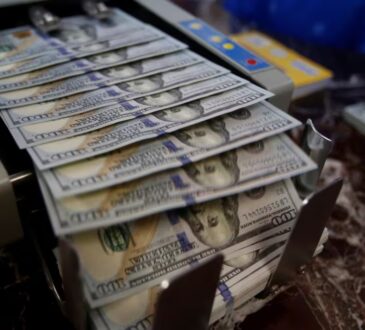
President Donald Trump has backed off from his threats against Fed Chair Jerome Powell.
He has softened his tone on trade with China, alternately suggesting he would be “flexible” and “very nice” and yet also repeating threats. China has not yet budged from its harsh first responses.
All this appears to be a reaction to changes in financial markets. Prices of stocks and bonds, along with long-term interest rates, have oscillated up and down in response to the daily verbal sallies from the White House.
Prices of major foreign currencies have also varied — almost entirely up in terms of their value of the dollar. Let’s consider the impact of this.
It takes 9.1% more dollars to buy a euro than it did on Trump’s Inauguration Day; 7.8% more to buy a British pound, 9.2% more for a Japanese yen. However, the Canadian dollar is only 3.5% more expensive in our currency and the Chinese renminbi exchange rate has barely budged at all.
Aside from the impact on Americans traveling abroad, what do such variations in currency values mean for our economy in general? Potentially a lot.
Changes in the value of one currency versus another are more important than most Americans understand. What causes these changes and how such fluctuations affect farm or manufacturing employment or output are as opaque as whether higher import tariffs are good or bad.
Consider the confusion that arises from the phrase “the value of the dollar.”
People can generally see this reflected in how many dollars it takes to buy goods and services. When people say the value of the dollar fell sharply under President Joe Biden, they refer to consumer prices that were 18% higher when Biden left office than when he came in. More dollars needed to buy the same stuff means the dollar is worth less that is was before.
But in financial markets, “the value of the dollar” also refers to the number of dollars that are needed to buy one unit of another currency. It took $4.93 to buy a British pound as World War I broke out in 1914 and only $1.33 this week. The “value of the dollar” rose compared to the pound.
These two different “values of a currency” — in terms of the quantities of goods and services one can buy in one’s own country versus the quantities of the same items in another currency — are related, but are not the same.
Yes, a country with prolonged high inflation often sees the exchange value of its currency fall. And one with low inflation, say Switzerland, may see the exchange value of its currency rise against the money of countries with higher inflation.
This is not always true, however. Ronald Reagan’s first term saw continued high inflation from the Ford and Carter years. Consumer buying power fell in the U.S. but the exchange value of the U.S. dollar rose. Four years after Reagan’s first inauguration, a dollar only bought 82% of domestic consumer goods and services in the U.S. that it had when he took the oath of office in 1981. But a buck also bought 2.15 times as many British pounds, 58% more pre-euro German marks and 26% more Japanese yen. Pretty good, huh?
This means that a Volkswagen Jetta priced at 16,000 deutschmarks in January 1981 cost a U.S. buyer $7,958. One at the same deutschmark price four years later would have cost only $5,046. Going the other way, a $1.75 U.S. bushel of corn would have been 3.52 deutschmarks in January 1981, but 5.55 deutschmarks in 1985.
A ton of Japanese-made steel priced at 80,000 yen cost $395 in 1981 but only $315 in 1985. Going the other direction across the Pacific, a $280 ton of U.S. soybeans cost a Japanese buyer 56,660 yen at the beginning of the period and 77,170 at the end.
These examples show hard realities that few people realize, but with broad implications for our economy. A “strong,” or high-priced, currency makes its nation’s exports expensive to world buyers while rendering imports cheap. It effectively subsidizes imports and taxes exports. This is good for consumers who want to buy cheap goods. But it punishes domestic producers — farmers, miners, mill and factory owners — along with people who work for them, because in a global supply chain, U.S. export customers can shop for a better price from countries with “weaker” currencies.
Why was the dollar so “strong” in the first half of Reagan’s presidency, despite high inflation at home? Because U.S. interest rates were high and foreigners needed dollars to earn those high rates on long-term U.S. Treasurys.
How did this come about? First, federal budget deficits had exploded. They averaged 2.2% of GDP over 20 years, 1960-1980. For the economically troubled Carter years they had been 2.4%. But with sharply increased defense spending coupled with tax cuts under Reagan, deficits exploded, hitting 5.8% for the fiscal year starting in September 1982. This was twice what it was in 1968 at the height of the Vietnam War and NASA’s Apollo moon program.
Bad enough, but President Jimmy Carter had appointed Paul Volcker as chair of the Federal Reserve Board. To end inflation, Volcker had made clear he would stamp the brakes on the money supply come hell, high water or anything Congress or the White House did. He kept his promise and interest rates soared. Some 30-year Treasury bonds went over 15% while prime rates for sound business loans hit 21.5%.
These were the highest real interest rates in the world. Investors everywhere wanted to earn them. So foreign money poured into the United States. With hordes of German and Japanese investors figuratively waving wads of marks and yen at anyone offering dollars, the value of the U.S. dollar set new records. This clobbered the U.S. steel industry, the U.S. auto industry and U.S. farming.
Granted, all three sectors had created some of their own problems.
Farmers had reacted to the 1972 devaluation of the dollar — when President Richard Nixon ended the Bretton Woods international payments system — by bidding up land prices year after year. Sales were financed by contracts-for-deed insulated from commercial mortgage requirements.
Complacently monopolistic steel and auto companies had entered into mutual suicide pacts with their unions, shunning new and cheaper steel processes and quality-control methods being introduced elsewhere with the short-term goal of saving jobs.
These problems had been evident for years, but with Reagan-era deficits and Volcker interest rates, “the wolf finally came” as noted in the title of an excellent history of steel’s demise.
What does that have to do with 2025, and today’s currency markets’ influence on White House policy changes?
Well, since a “strong” currency promotes imports and stifles exports, one can reduce this imbalance with tariffs, as Trump is attempting to do, but also by reducing, or “weakening” the exchange value of one’s currency. That is the “currency manipulation” for which we long have condemned other countries.
Trump Treasury Secretary Scott Bessent, erstwhile adviser Steve Bannon — disreputable but still influential — and other Trump whisperers argue that beyond raising tariffs, we need to make it more difficult for trade-surplus nations like China to invest dollars in U.S. bonds. That would drive down the value of the dollar, reduce U.S. imports and increase employment and output here. But, like tariffs, it also would raise inflation. More on this in future columns.
St. Paul economist and writer Edward Lotterman can be reached at stpaul@edlotterman.com.



